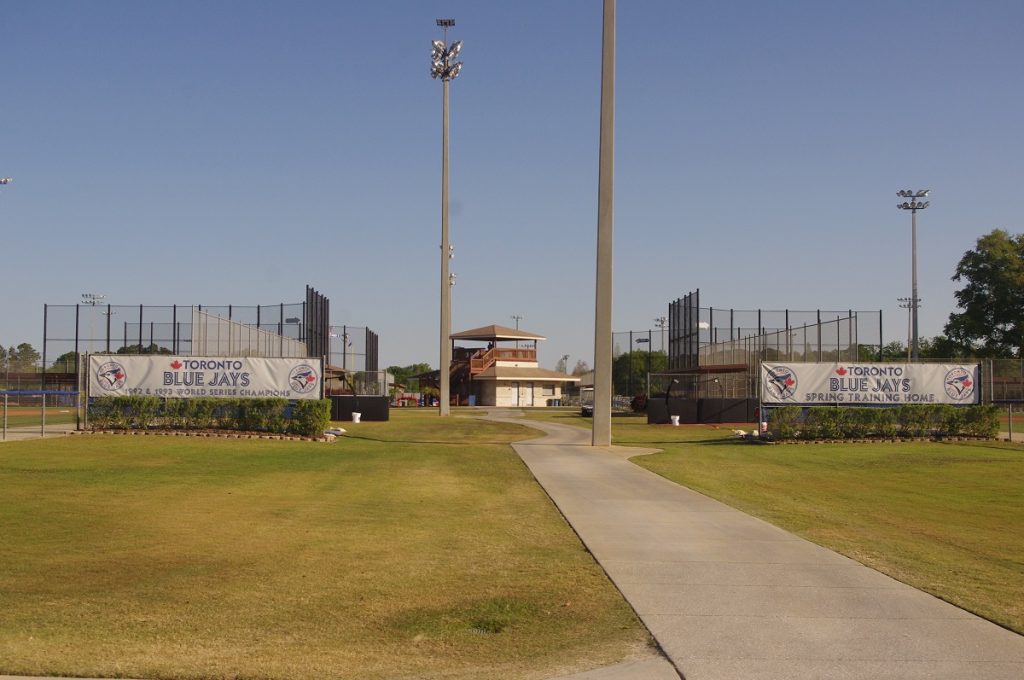Blue Jays to increase pay to minor leaguers
Toronto Blue Jays minor leaguers are training at the Bobby Mattick Complex in Dunedin, Fla., this spring. Photo: Jay Blue
By Jay Blue
Blue Jays from Away
As reported by Emily Waldon and Ken Rosenthal at The Athletic, the Toronto Blue Jays have announced they will be raising the pay of their minor league players by “more than 50 percent.”
In a time where MLB and MiLB are under pressure from lawsuits and public opinion, this announcement shows that the Toronto Blue Jays are at the vanguard of player development. Waldon in particular, has been banging the drum of increasing pay for minor leaguers for quite a while, via her Twitter account and, most recently, in her powerful piece for The Athletic.
50% is a lot in terms of a team’s budget and, as Ben Cherington told The Athletic, “While it’s not going to be life-changing for any particular player, in total it’s a real sum of money. So, obviously, there’s a budgeting process as well. We had to go through that.”
That is definitely true. With pay starting from about $1160 to $1500 per month in A-ball and rising to $2150 in a player’s first year in triple-A, it would take their total yearly pay from a low of $6380 (approximately) to around the $10,000 at the lower end of the scale and from $11,825 to over $15,000 at the higher end of the scale (for first-year triple-A players; players who are repeating the level get raises). So while the raises may not amount to a huge amount overall for the individual players, it's likely a significant investment by the team, amounting to several hundreds of thousands of dollars (if not up to a million dollars) per year. Again, this isn't a lot in the overall scheme of things for a team that is paying Freddy Galvis $4,000,000 to be a defensive-minded shortstop, but in terms of the overall budget for minor league operations, it's likely a large increase in budget.
This move by the Blue Jays doesn’t change some of the bigger logistical problems that players face in the minor leagues. As Waldon has reported, players tend to find it challenging to rent an apartment after getting paycheques and the transitory nature of a minor league player, who can be sent to another team at any time, and the fact that they don’t get paid during spring training makes it tough for players to even come up with a security deposit to rent a place when the season starts.
What it will do is ease some of the pressures in season, such as allowing players to eat better. The Blue Jays have been making a greater effort to increase the quality of the pre-game and post-game spreads in their minor league clubhouses and, in 2019, have added dieticiansto many of their full-season staffs. In terms of player development, this is going to allow the Blue Jays to have minor leaguers with slightly less stress in their lives (anyone who’s read Dirk Hayhurst’s books know how stressful it can be when players are in competition with everyone else at their position in the organization), hopefully enabling the Blue Jays to become more efficient at developing their talent.
The Blue Jays’ emphasis on technology in the minor leagues (and in the major leagues) and their Department of High Performance, brought in with current president Mark Shapiro is also focused on developing the Blue Jays’ minor leaguers at a greater rate. I believe that the move to pay minor leaguers more is part of a larger strategy and will work hand-in-hand with the other programs that have been implemented.
I reached out to Ben Cherington to ask him about this and he wrote:
“I’d say the pay raise is related but different than the investment in high performance resources, including nutritionists and food. We have made significant investments in the areas of nutrition and wellness (mental performance, sleep strategies, workload management, etc) that are offered directly …”
So as Cherington writes, the money goes together with the improvements the team is trying to make but it's definitely up to the players themselves to be able to use the additional money wisely.
In some ways, this is still a half-measure when looking at things from the point of view of a minor league player. They’re still not paid for spring training. They’re still not paid in the offseason. They’re still not getting paid for the hours that they spend training or doing public events for the team. They’re still not getting a lot of meal money on the road. They’re still subjected to difficult travel schedules where sleep is often at a premium.
But it’s a start, and the Blue Jays are ahead of the curve.
If you like us here, like us on Facebook!
The 2019 Toronto Blue Jays Minor League Handbook is now available! Visit the Handbook page for more information!

